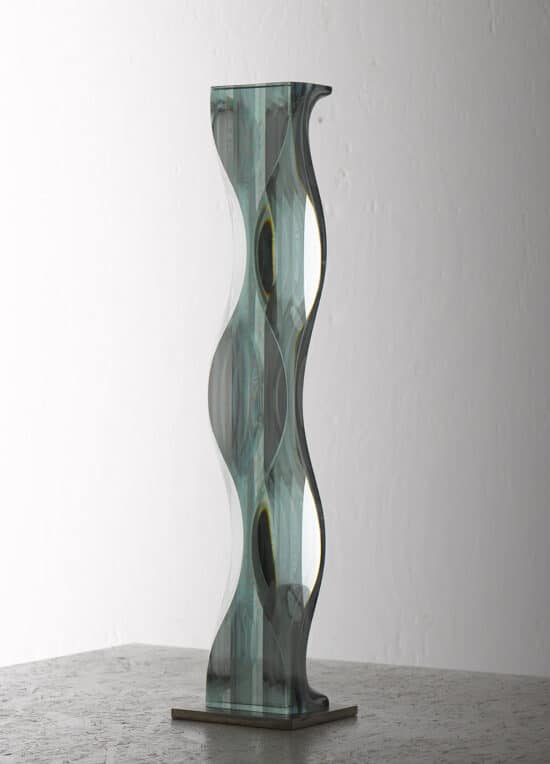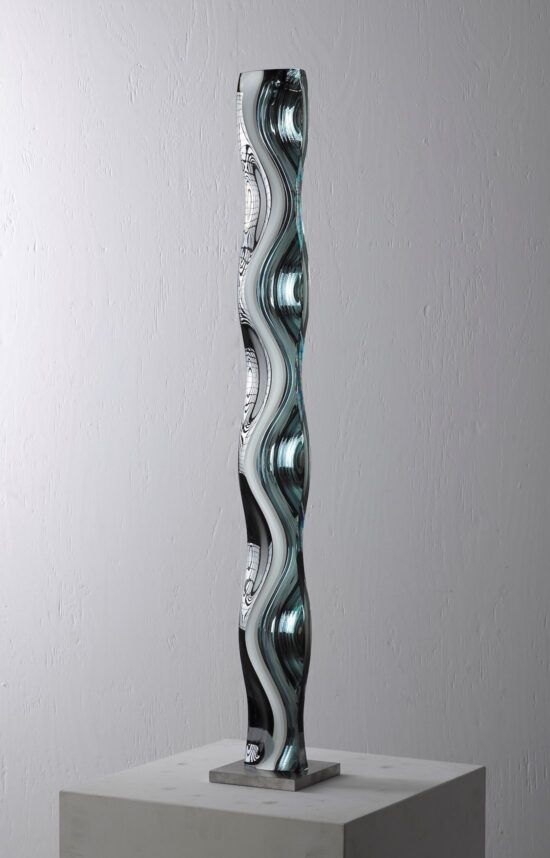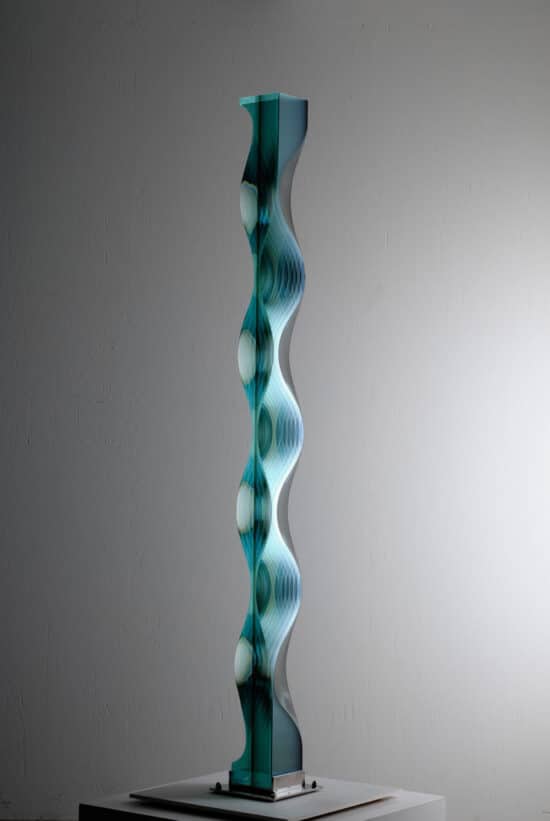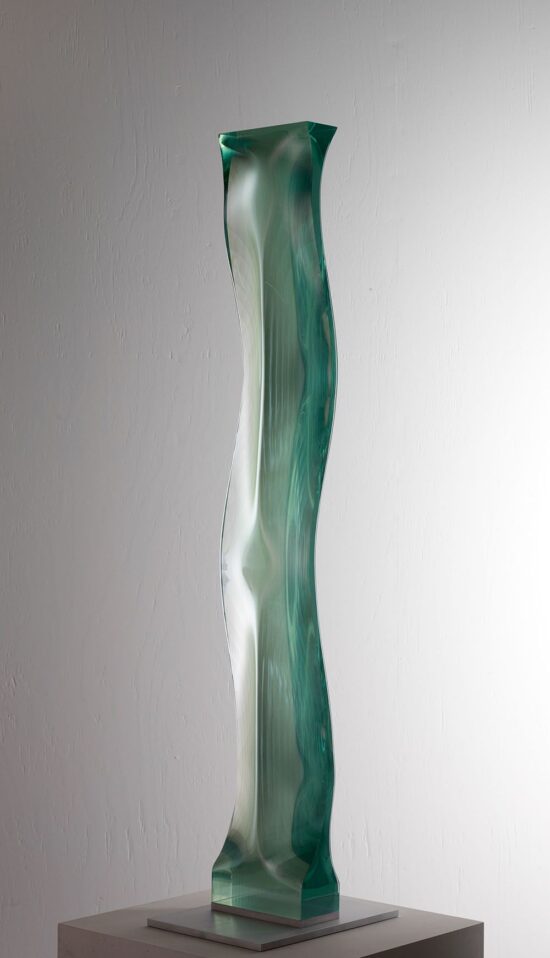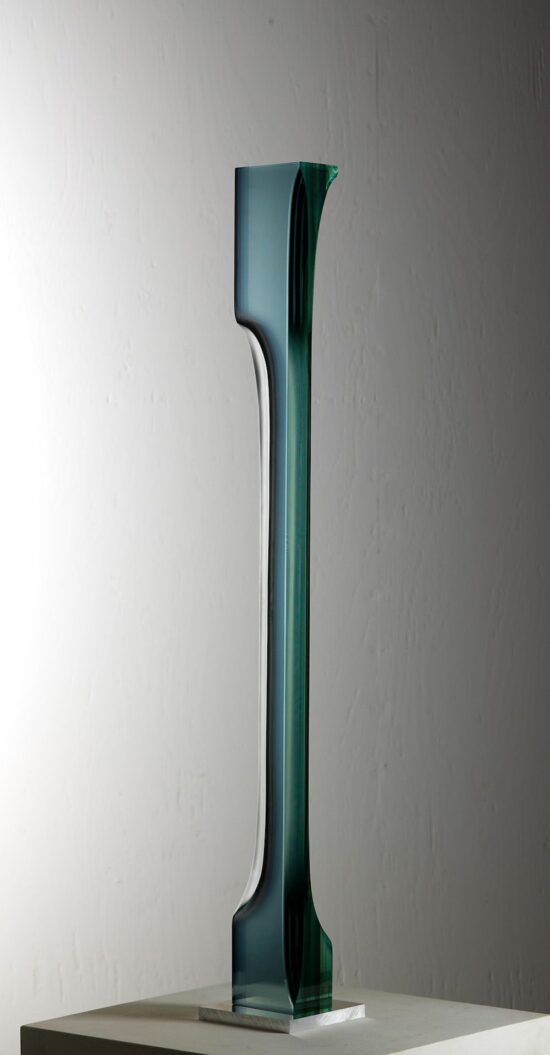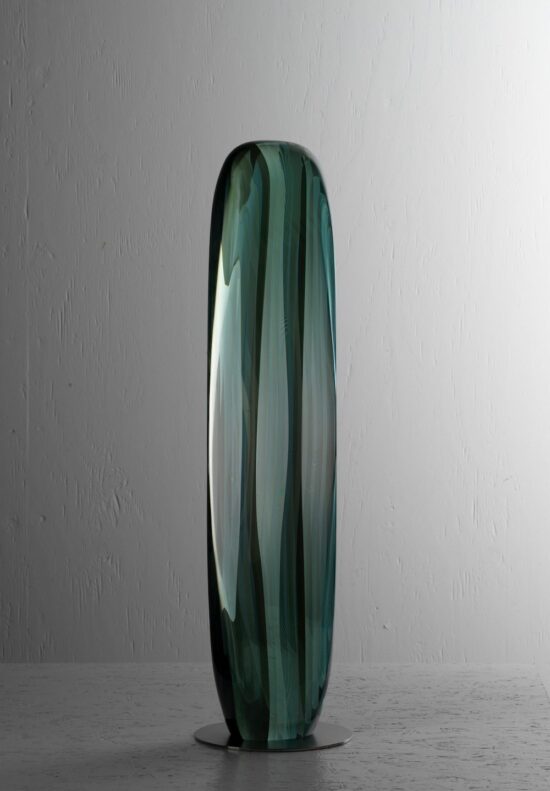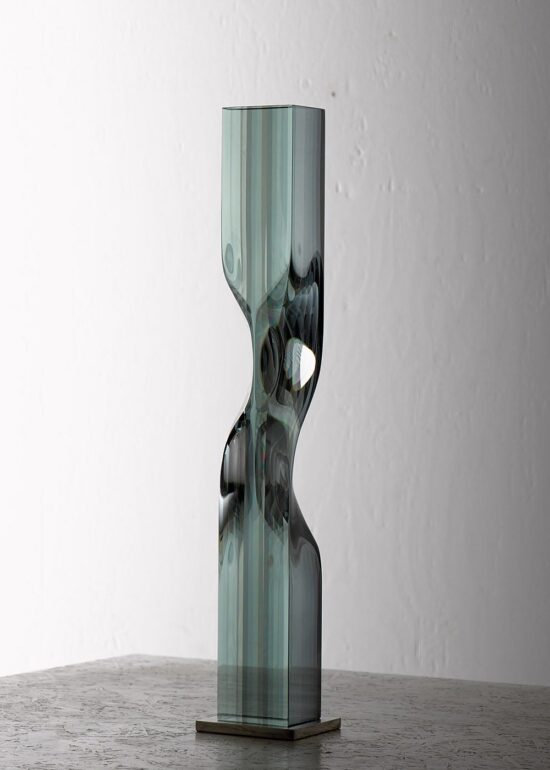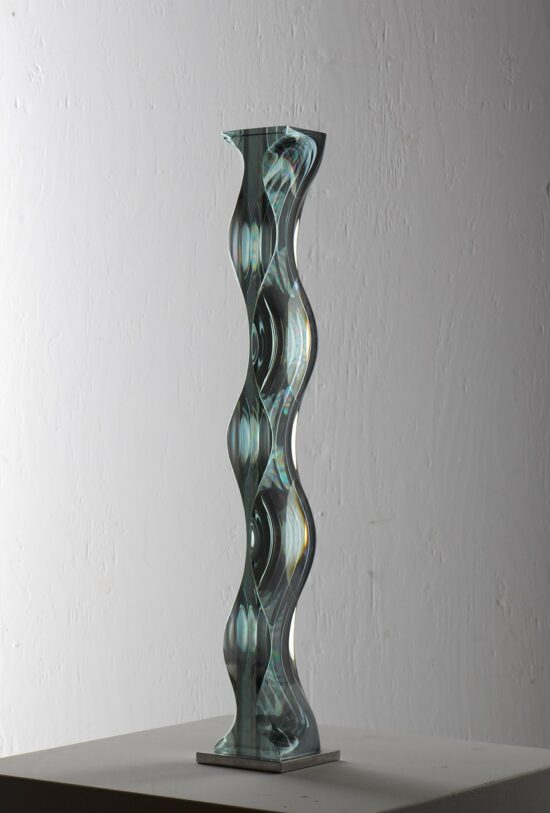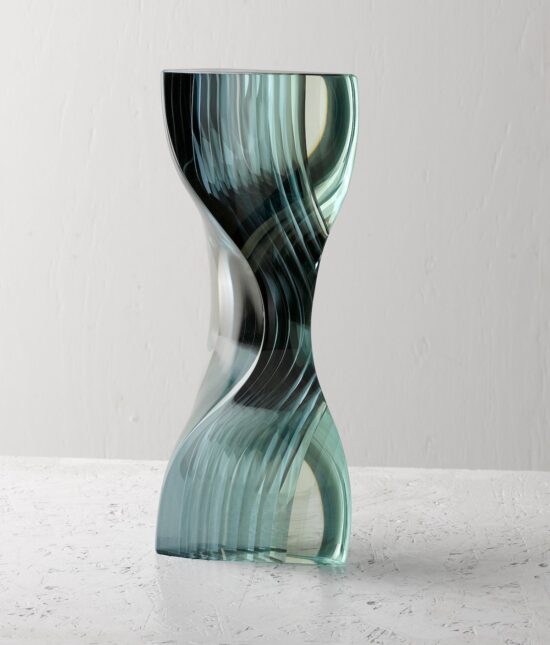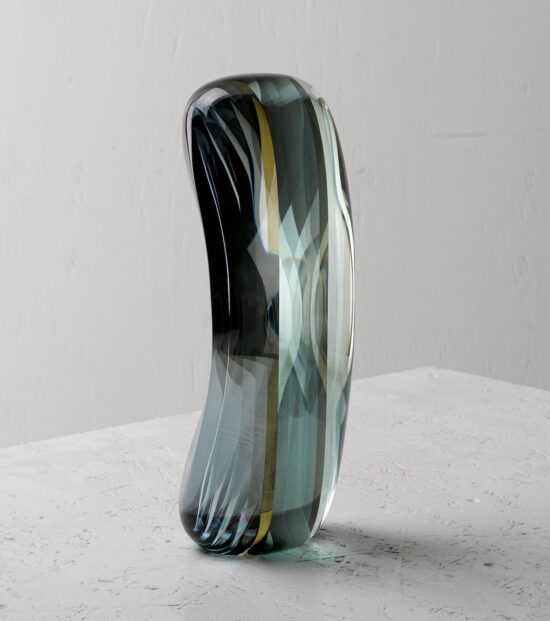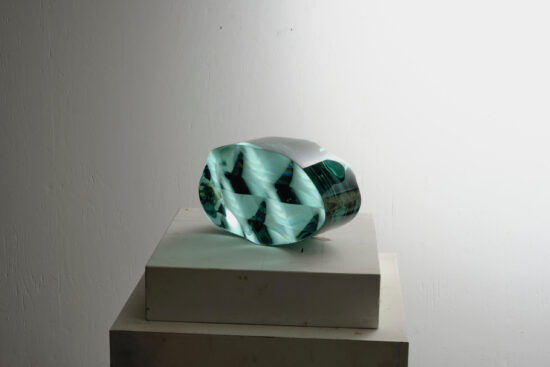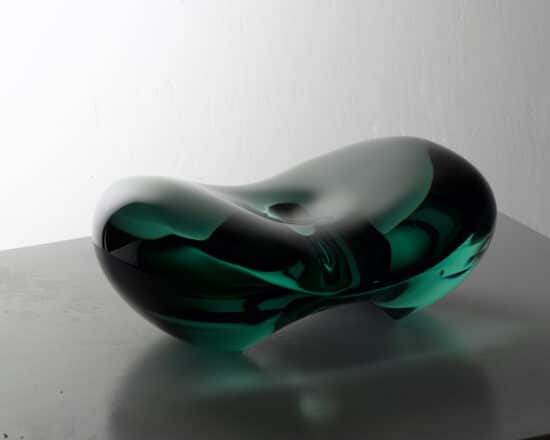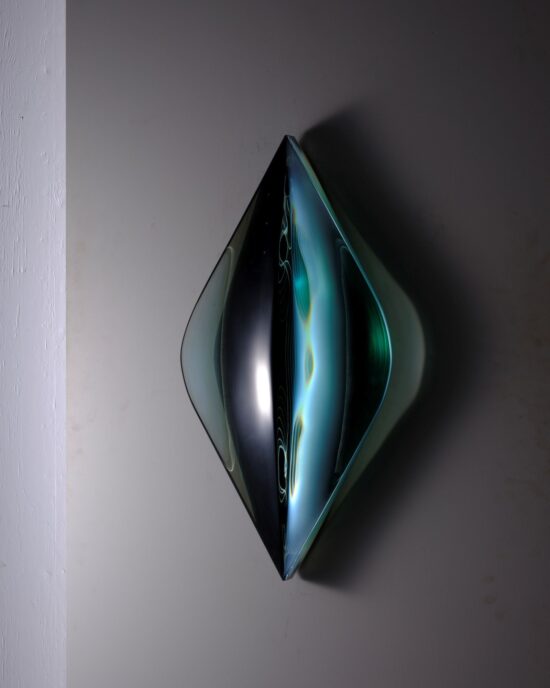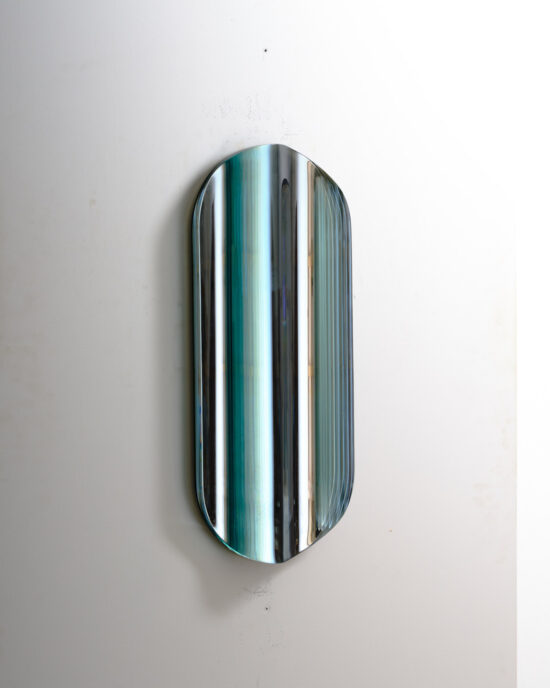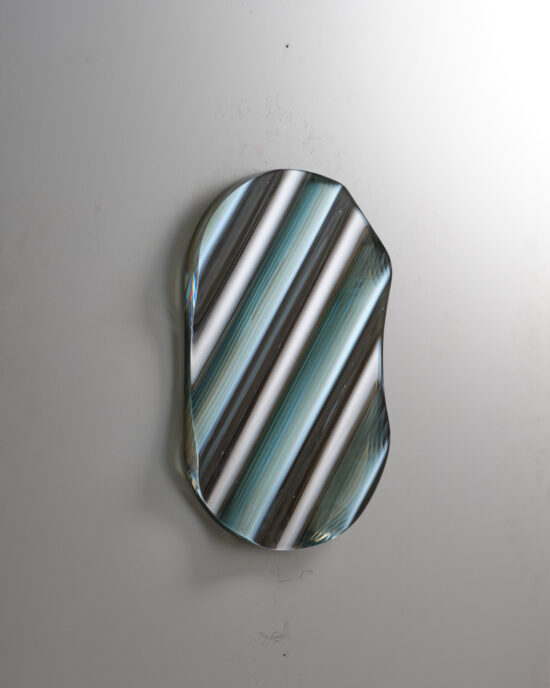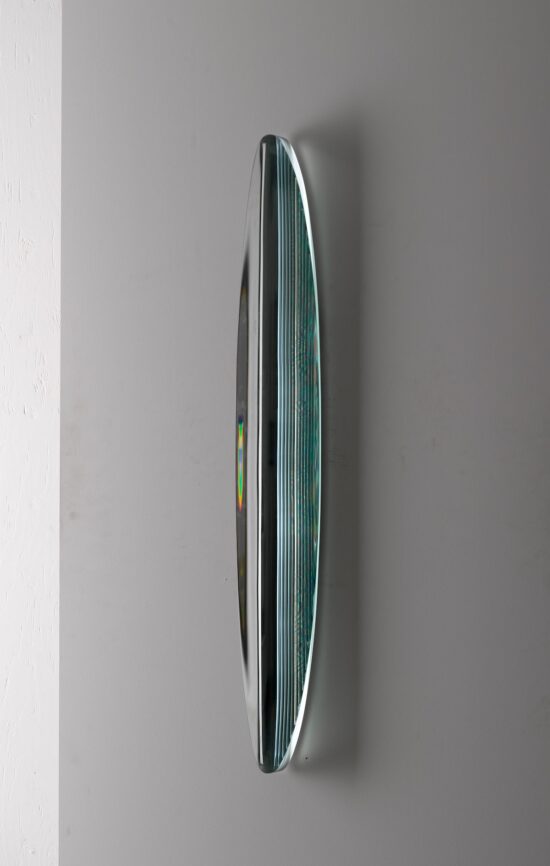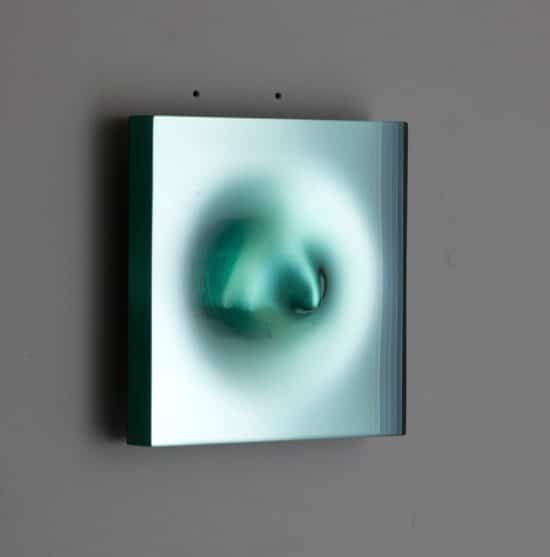Move
Form
Projection
Biography
The Japanese artist Toshio Iezumi creates unique contemporary sculptures using sheets of glass and a technique traditionally used for carving stone. His elegant and fascinating abstract glass sculptures change appearance depending on where they are placed and the position of the viewer.
Material and technique: a master of glass sculpture
Toshio Iezumi was born in 1954 in Ashikaga, Tochigi Prefecture, and currently lives near Tokyo. Drawn to working with glass, he enrolled at the Tokyo Glass Art Institute in 1983. There he learned a range of techniques for working with his chosen material: blowing, casting, cutting, enamelling and sandblasting. Two years later, after obtaining his diploma, he devoted himself to developing the technique that has characterised his work ever since. His glass sculptures are the result of a long creative process: there are different stages requiring specialised tools, which have taken a great deal of practice and commitment to master.
The artist starts by preparing the material he has favoured since the start of his career: sheets of glass, between 2mm and 2cm thick. These sheets of glass are harder than crystal glass but less transparent, and slightly green because of their iron content. The contemporary sculptor laminates them, gluing them together with a clear fluid UV glue to create a block. The resulting block of glass has a deeper, more intense shade of green.
He then uses an angle grinder with a diamond blade, normally used for carving stone, to cut the block into his desired shape. The waves and convex and concave shapes are created at this stage. The next step is to smooth out the lines in the surface using six different grades of grinding grits, from roughest to smoothest. Finally, the glass is polished using a felt buff and cerium oxide. This makes the glass sculpture transparent, and completely changes its appearance.
“When shape and texture are well balanced, an ordinary object becomes extraordinary – an artwork.” The artist seeks the form first, grinding the glass into shape, and then creates the texture (or rather, a visual distortion) through polishing. He adjusts the form and reworks the texture, repeating the cycle until he finds the perfect balance from which the sculptural artwork emerges.
Material and technique are thus the two most significant aspects of his art. He explains: “For my works to have something beyond my intention, I concentrate on grinding glass. In grinding glass, I have a conversation with it through my body: I ask the glass and the glass answers me. I ask the glass with my hands and receive its answer with my eyes. […] My works are born from such conversation”.
Glass sculptures that play with the viewer’s perception
Assembling the sheets of glass in this way give the artist a lot of freedom to experiment with shape (round, oval, rectangular), orientation (horizontal, vertical, mural) and size (from small to monumental). His series of sculptures has evolved over the years, enriching his body of work with a great variety.
The physical properties that allow glass to transmit, reflect and refract light mean the works change depending on their surroundings and the viewer’s perspective. To view these glass sculptures is to be intrigued by their distortions and visual illusions. They are disorientating and alluring at the same time, making us want to look closer and even touch them in order to understand their volumes, depths and different shades of colour.
A long career in Japan and worldwide
Toshio Iezumi has a career to be proud of: since 1985 he has received a number of prizes and exhibited in dozens of museums, galleries, biennials and art fairs in Japan and worldwide. His glass abstract sculptures are included in several major public collections, such as those of the New York Museum of Art and Design, the Boston Museum of Fine Arts and the Tokyo National Museum of Modern Art. The artist has also undertaken several commissions for hotels, offices, public institutions and universities. He had taught as a professor at the Kurashiki University of Science and Arts for over 20 years (1995-2016).
CV
Education
- 1985 – Graduated from Tokyo Glass Art Institute
- PROFESSIONAL
- 2016-2004 – Professor: Kurashiki University of Science and the Arts
- 2004-1999 – Associate Professor: Kurashiki University of Science and the Arts
Solo exhibitions
- 2019 – “INTO LIVING” Cassina Ixc (Tokyo, Japan)
- 2017 – “Grind to Form” Toyama Glass Art Museum (Toyama, Japan)
- 2016 – “Miki City Horimitsu Art Museum (MIki Hyogo, Japan)
- 2009 – Gallery Tamura (Hiroshima, Japan)
- 2008, 2006, 2004, 2002 – Chappell Gallery (New York, U.S.A.)
- 2008, 2006, 2004, 2002 – Gallery Tamura (Hiroshima, Japan)
- 2008, 2006, 2004, 2002 – Studio UNO (Tokyo, Japan)
- 2008, 2006, 2004, 2002 – Another Movement (Kanazawa, Japan)
- 2003 – Gallery-Ikuko (Kurashiki Okayama, Japan)
- 2003 – Another Movement (Kanazawa, Japan)
- 2001 – AD&A Gallery (Osaka, Japan)
- 2001 – Exhibition Space (Tokyo, Japan)
- 2000, 1998 – Chappell Gallery (Boston, U.S.A.)
- 1999 – Studio UNO (Tokyo, Japan)
- 1999 – Contemporary Art NIKI (Tokyo, Japan)
- 1998 – Habatat Galleries (Michigan, U.S.A.)
- 1997 – Studio UNO (Tokyo, Japan)
- 1996 – AD&A Gallery (Osaka, Japan)
- 1995 – Gallery Nakama (Tokyo, Japan)
- 1994, 1993, 1992 – Art Space Niji (Kyoto, Japan)
- 1993, 1992, 1990, 1987, 1986 – Gallery Genkai (Tokyo, Japan)
- 1985 – Gallery Iteza (Kyoto, Japan)
Group exhibitions
- 2021 – SculptureRocs (Perth, Australia)
- 2021 – “The Challenge of Glass” Toyama Glass Art Museum (Toyama, Japan
- 2021-2018, 2015-2011 – Sculpture by the Sea Cottesloe
- 2019, 2017-2011 – Annual Glass International Award – Habatat Galleries (Michigan, U.S.A.)
- 2019, 2017-2011 – Sculpture by the Sea Cottesloe (Perth, Australia)
- 2018 – “Art exhibition traveling with glasses” Aomori Museum of Art, Shimane Art
- 2018 – Museum,Shizuoka Prefectural Museum of Art (Aomori,Shimane,Shizuoka, Japan)
- 2018 – Asia Contemporary Art Show Spring(Hong Kong)
- 2017 – Representation of Flat Glass – Notojima Glass Art Museum (Ishikawa, Japan)
- 2017 – Asia Contemporary Art Show Fall (Hong Kong)
- 2016-1995 – SOFA (Chicago, U.S.A.)
- 2013 – ARTE FIERA Bologna (Bologna, Italy)
- 2013 – ART FAIR TOKYO (Tokyo, Japan)
- 2012 – Contemporary Glass Sculpture – Orlando Museum of Art(Orlando,U.S.A.)
- 2010 – Okayama Art Spanning Thousand Years – The Okayama Prefectural Museum of Art (Okayama, Japan)
- 2010 – Toshio Iezumi & Park Sung Won – SKLO (Seoul, Korea)
- 2010 – 19th Fugaku Biennale – Shizuoka Prefectural Museum of Art (Shizuoka, Japan)
- 2004 – DISTANCE Artists from Tochigi – Tochigi Prefectural Museum of Fine Arts (Utsunomiya Tochigi, Japan)
- 2003 – Outspoken Glass – Hokkaido Museum of Modern Aet (Sapporo, Japan)
- 2003 – The Okayama Prefectural Museum of Art (Okayama, Japan
- 2001 – ANCIENT GLASS Challenge by Glass Artists – Ancient Orient Museum (Tokyo, Japan)
- 2001 – Contemporary Glass Exhibition – Beijing Art Museum / Shanghai Art Museum (Shanghai, China)
- 2001 – Glass 2001 in Notojima, Glass Art Museum (Ishikawa , Japan)
- 2000 – Millennium Glass – Kentucky Art and Craft Foundation (Kentucky, U.S.A.)
- 2000 – “VESSELS” The International Exhibition of Glass – Koganezaki Glass Museum (Shizuoka ,Japan)
- 1999 – 2000 Years of Japanese Glass: From the Yayoi Period of the Present Day – Suntory Museum (Tokyo, Japan)
- 1999 – Glass Art – History and Now – Okayama Orient Museum (Okayama, Japan)
- 1998 – Glass Art in Our Time – Nigata City Art Museum (Niigata, Japan)
- 1998 – “VESSELS” The International Exhibition of Glass – Koganezaki Glass Museum (Shizuoka ,Japan)
- 1997 – An International Contemporary Glass Exhibition – Hsinchu Cultural center (Hsinchu, Taiwan)
- 1997 – THE GLASS SKIN – Hokkaido Museum of Modern Art (Sapporo, Japan), Corning Museum of Glass (Corning, U.S.A.)
- 1997 – Kunstmuseum Dusseldorf (Dusseldorf, Germany)
- 1997 – Made in Japan,Glasmuseum (Ebeltoft,Denmark)
- 1996 – Venezia Aperto Vetro – Museo Correr (Venezia, Italia)
- 1996 – Glass Art Today – Rias Ark Museum of Art (Miyagi, Japan)
- 1995 – The 16th Exhibition of Contemporary Japanese Sculpture – Ube Museum of Outdoor Sculpture (Yamaguchi, Japan)
- 1994 – World Glass Now’94 – Hokkaido Museum of Modern Art (Sapporo, Japan)
- 1994 – The 23rd Contemporary Art Exhibition of Japan – Tokyo Metropolitan Art Museum (Tokyo, Japan)
- 1994 – Japan Contemporary Glass Art Exhibition – Notojima Glass Art Museum (Notojima Ishikawa, Japan)
- 1994 – Glass Art Now Exhibition 1994 – Akita Senshu Museum of Art (Akita, Japan)
- 1993 – The 3rd Biennial Exhibition of Arts in Makurazaki Nanmeikan Museum (Kamomura Chiba, Japan)
- 1993 – The Suntory Prize ’92 – Suntory Museum of Art (Tokyo, Japan)
- 1992 – Exhibition of Glass Craft in Notojima – Notojima Glass Art Museum (Notojima, Japan)
- 1991 – World Glass Now ‘91 – Hokkaido Museum of Modern Art (Sapporo, Japan)
- 1991 – The Suntory Prize ‘91 – Suntory Museum (Tokyo, Japan)
- 1991 – Notojima Open-Air Glass Art Competition – Notojima Glass Art Museum (Ishikawa, Japan)
- 1990 – Art Today Tochigi – Tochigi Prefectural Museum of Fine Arts (Utunomiya Saitama, Japan)
- 1990 – Art Today Tochigi – Tochigi Prefectural Museum of Fine Arts (Utunomiya Saitama, Japan)
- 1990 – Glass Art’90 – The Hakone Open-air Museum (Hakome Kanagawa, Japan)
- 1990 – Tokyo Glass Art ’90 (Tokyo, Japan)
- 1990 – 12th The Biennale of Kobe at the Suma Detached Palace Garden, Contemporary Sculpture Exhibition (Hyogo, Japan)
- 1989 – Yokohama Biennial Open-air Sculpture Exhibition’89 (Yokohama Kanagawa, Japan)
- 1986 – New Glass Review7 – Corning Museum of Glass (New York, U.S.A.)
Collections
- Corning Museum of Glass (Corning, USA
- Museum of Art and Design, New York (New York, USA)
- Boston Museum of Fine Arts (Boston, USA)
- Museum of Art and Archaeology, University of Missouri (Missouri, USA)
- Newark Museum of Art (Newark, USA)
- Los Angeles County Museum of Art (California, USA)
- MFAH The Museum of Fine Arts (Houston, USA)
- Henry Ford Museum (Detroit, USA)
- National Museum of Modern Art (Tokyo, Japan)
- Hokkaido Museum of Modern Art (Sapporo Hokkaido, Japan)
- 21st Century Museum of Contemporary Art (Kanazawa, Japan)
- Okayama Prefectural Museum of Art (Okayama, Japan)
- Suntory Museum (Tokyo, Japan)
- Tochigi prefectural Museum of Fine Art (Utsunomiya Tochigi, Japan)
- Notojima Glass Art Museum (Nanao Ishikawa, Japan)
- Ashikaga Museum of Art (Ashikaga Tochigi, Japan)
- Koganezaki Glass Museum (Shizuoka, Japan)
- Toyama Glass Art Museum (Toyama, Japan)
Awards & Residencies
- 2008 – “Second Grand Prize” 19th Fugaku Biennale Shizuoka Prefectural Museum of Art (Shizuoka, Japan)
- 2007 – “Silver Prize” International Exhibition of Glass Kanazawa 2007 (Ishikawa, Japan)
- 2007 – “Staff Choice Prize” Sculpture by the Sea 2007 (Bondi / Sydney, U.S.A.)
- 2000 – “Honorary Prize – VESSELS” The International Exhibition of Glass – Koganezaki Glass Museum (Shizuoka, Japan)
- 1993 – “Saji Encouragement Prize” The Suntory Prize’92 – Suntory Museum (Tokyo, Japan)
- 1993 – “Second Grand Prize” Asahi Contemporary Crafts Exhibition’93 (Tokyo / Osaka, Japan
- 1993 – “Honorary Prize” Kanazawa Arts and Crafts Competition’93 (Ishikawa, Japan)
- 1993 – “Encouragement Prize” Glass Sculpture Competition’93 – Brighton Hotels (Kyoto / Chiba, Japan)
- 1992 – “Silver Prize” The International Exhibition of Glass Kanazawa’92 (Ishikawa, Japan)
- 1991 – “Achievement Prize” Notojima Open-Air Glass Art Competition – Notojima Glass Art Museum (Ishikawa, Japan)
- 1991 – “Prize” Adachi Outdoor Sculpture Competition (Tokyo, Japan)
- 1986 – “Honorary Prize” The International Exhibition of Glass Craft’86 (Kanazawa / Ishikawa, Japan)
- 1986 – “Gold Prize” ‘86 Takaoka Crafts Exhibition (Toyama, Japan)

